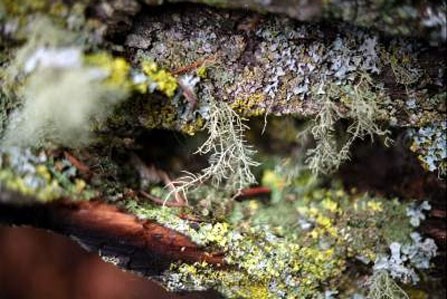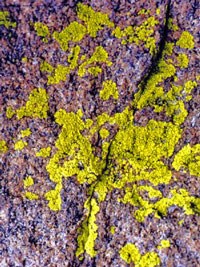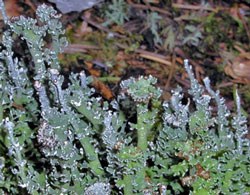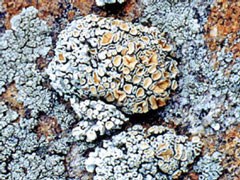
Have you ever noticed how the surface of an old log or boulder can be painted with a multitude of different colored organisms? Lichens are among the most common and most overlooked organisms in Rocky Mountain National Park. They grow on rock surfaces, trees, and downed logs, and on the ground; Some even grow free of substrate and blow around like miniature tumbleweeds. Lichens are actually a partnership composed of two organisms - a fungus and a primitive plant called an alga. Fungi (pleural of fungus) are colorless organisms that generally make their living decomposing other organisms, while algae (plural of alga) can make their own food by photosynthesis. In the composite association we call lichens, the fungi provide the protection from the environment, while the algae provide the food. This kind of arrangement where both organisms benefit from their association is called a symbiotic relationship. 
NPS Photo Lichens have been nicknamed "natures pioneer" because they can colonize bare rock and are usually first to establish on newly exposed surfaces. Some even have the capability to speed up the weathering process by producing an acid that breaks down rocks and helps form soil. Soil formation is extremely slow and takes not decades but centuries for the rocky substrate to breakdown. The rocks and minerals where they make their home vary in texture, chemical composition, and water holding capacity.The park is comprised mostly of metamorphic and granite rocks. The rock lichens you find here are often adapted to colonization on these types of rocks. Lichens are also very slow growing with some species only adding a few millimeters of growth in a single year. Because they grow slowly, large individual lichens can be hundreds or even thousands of years old. Because they are some of the first "pioneers" to set up residence on newly exposed rock, scientists in other areas of the world have used some of these large lichens to estimate when glacial ice has melted from an area. 
NPS While many lichens can be challenging to identify, some that occur in Rocky Mountain National Park are quite easy. Characters used for identification usually include color, texture, or growth form, and the form of the reproductive structures called apothecia. Apothecia are usually small, rimmed cups or disks on the surface of the lichen. Lecidea tessellata is a common gray crust with black apothecia appearing as spots throughout the crust. The word tessellata in its name comes from the Latin word for tiled, like a tiled floor. Candelariella is an egg yolk-yellow colored crust, and Caloplaca which is a bright orange crust. Pleopsidium is a bright chartreuse colored lichen which is always found on vertical surfaces. Rhizoplaca chrysoleuca is a somewhat leafy looking lichen with a pale green color, except for the apothecia which are peach colored. 
NPS photo Lichens are endlessly fascinating and extremely varied. Next time you are out hiking a trail or enjoying a scenic vista, take a look at the rock surfaces, or the log along the trail, tree trunks or even up in the tree branches Once you start watching for them, you will find they occur in all sorts of situations. A hand lens or magnifying glass and a field guide can help you start trying to identify them. But beware, even if you don't try to identify them, you will be amazed by the variety colors, textures, and shapes you see if you only take time to look at this fascinating compound "organism." To lean more on the recorded lichens of Rocky Mountain National Park view the Lichens List. |
Last updated: May 5, 2018
